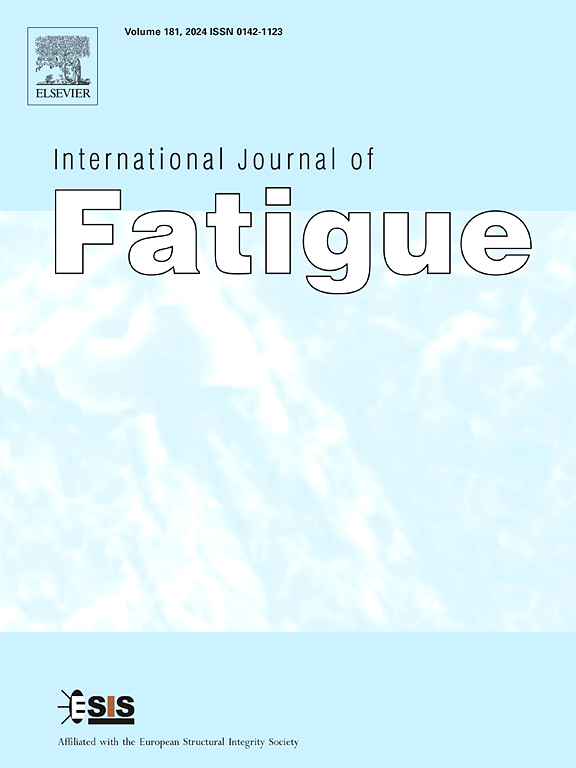Advanced strain-based approaches for monitoring crack tip position in adhesively bonded joints subjected to mixed mode fatigue loading
IF 5.7
2区 材料科学
Q1 ENGINEERING, MECHANICAL
引用次数: 0
Abstract
In most structures, adhesive joints are subject to a combination of mode I (opening) and mode II (in-plane shear) loading. Most of the current research on adhesive joints, however, focuses on pure modes. The resistance of adhesive joints to fracture is investigated through crack propagation tests, during which the crack length must be measured with high accuracy. Visual Testing is usually employed, because it is the standardized method, but it may be uncertain. Other techniques, such as Digital Image Correlation, may be employed to increase accuracy. In this work, a Cracked Lap Shear specimen is used to study crack monitoring under mixed mode loading. Two techniques were used to measure crack length: Digital Image Correlation and distributed backface strain monitoring using Optical Backscatter Reflectometry (OBR) fibre sensors. Both techniques were shown to provide reliably accurate measurements. In the first part of this work, a method is presented which is able to accurately measure the crack length using Digital Image Correlation without needing to rely on Visual Testing; additionally, the deformation of the adhesive layer was investigated, which can provide an insight into the adhesive’s behaviour under mixed mode loading. Then, it is shown that accurate crack length measurements may be obtained with distributed backface strain monitoring by optical fibres applied to either side of the joint. Given fibre sensors’ low profile and ease of installation, OBR’s ability to measure crack growth offers significant potential for in-service monitoring of bonded structures.
基于应变的粘接接头裂纹尖端位置监测方法
在大多数结构中,粘接接头受到I型(开口)和II型(面内剪切)载荷的组合。然而,目前对粘接的研究大多集中在纯模态上。通过裂纹扩展试验研究粘接接头的抗断裂能力,在试验过程中必须高精度地测量裂纹长度。视觉测试通常被采用,因为它是标准化的方法,但它可能是不确定的。其他技术,如数字图像相关,可用于提高精度。本文采用裂纹搭接剪切试件,研究了混合模式荷载作用下的裂纹监测。测量裂缝长度采用了两种技术:数字图像相关和使用光学后向散射反射(OBR)光纤传感器的分布式背面应变监测。这两种技术都能提供可靠准确的测量结果。在本文的第一部分中,提出了一种利用数字图像相关技术来精确测量裂纹长度的方法,而不需要依赖于视觉测试;此外,研究了胶粘剂层的变形,这可以深入了解胶粘剂在混合模式载荷下的行为。结果表明,在接头两侧施加光纤进行分布式后面应变监测,可以获得精确的裂纹长度测量结果。考虑到光纤传感器的低姿态和易于安装,OBR测量裂缝扩展的能力为粘结结构的在役监测提供了巨大的潜力。
本文章由计算机程序翻译,如有差异,请以英文原文为准。
求助全文
约1分钟内获得全文
求助全文
来源期刊

International Journal of Fatigue
工程技术-材料科学:综合
CiteScore
10.70
自引率
21.70%
发文量
619
审稿时长
58 days
期刊介绍:
Typical subjects discussed in International Journal of Fatigue address:
Novel fatigue testing and characterization methods (new kinds of fatigue tests, critical evaluation of existing methods, in situ measurement of fatigue degradation, non-contact field measurements)
Multiaxial fatigue and complex loading effects of materials and structures, exploring state-of-the-art concepts in degradation under cyclic loading
Fatigue in the very high cycle regime, including failure mode transitions from surface to subsurface, effects of surface treatment, processing, and loading conditions
Modeling (including degradation processes and related driving forces, multiscale/multi-resolution methods, computational hierarchical and concurrent methods for coupled component and material responses, novel methods for notch root analysis, fracture mechanics, damage mechanics, crack growth kinetics, life prediction and durability, and prediction of stochastic fatigue behavior reflecting microstructure and service conditions)
Models for early stages of fatigue crack formation and growth that explicitly consider microstructure and relevant materials science aspects
Understanding the influence or manufacturing and processing route on fatigue degradation, and embedding this understanding in more predictive schemes for mitigation and design against fatigue
Prognosis and damage state awareness (including sensors, monitoring, methodology, interactive control, accelerated methods, data interpretation)
Applications of technologies associated with fatigue and their implications for structural integrity and reliability. This includes issues related to design, operation and maintenance, i.e., life cycle engineering
Smart materials and structures that can sense and mitigate fatigue degradation
Fatigue of devices and structures at small scales, including effects of process route and surfaces/interfaces.
 求助内容:
求助内容: 应助结果提醒方式:
应助结果提醒方式:


